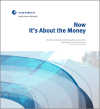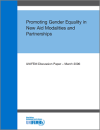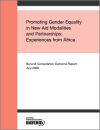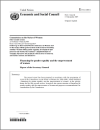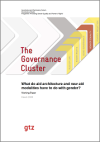TROUVÉ 58
The background paper was prepared for the Commonwealth Secretariat.
This is the final report of a joint three-year project (2004-2006) between Denmark, Finland, Iceland, Norway and Sweden.
The publication decribes two main features:
1. Development in the Kyrgyz Republic, an institutional mechanism to promote
gender equality, responsible for the formulation of national programs and
strategies for gender equality and women's empowerment;
1. Development in the Kyrgyz Republic, an institutional mechanism to promote
gender equality, responsible for the formulation of national programs and
strategies for gender equality and women's empowerment;
This paper provides a gender analysis of the new aid agenda as outlined in the Paris Declaration.
This report reflects country-level experiences shared at the Burundi regional consultation on Aid Effectiveness and Gender Equality in Africa in July 2006 consultation on the gender equality opportunities and challenges arising from aid reform processes.
The present report of the UN Secretary-General on Financing for gender equality and the empowerment of women, January 2008 has been prepared in accordance with the programme of work of the Commission on the Status of Women for 2007-2009, which identified Financing for gender equality and the em
This document prepared by the Working Party on Aid Effectiveness (WP-EFF) provides background information on the High Level Forum 4. It includes a description of the purpose, structure, substantive ;themes, preparation process and milestones.
This paper by Stephanie Seguino, University of Vermont Date in March 2009 argues that the economic and financial crisis provides an opportunity to rethink the role of government in the economy.
The purpose of this GTZ working paper is to provide guidance for the mainstreaming of a gender approach in new aid architecture and aid modalities. The author argues that gender equality is still not being adequately addressed or mainstreamed in current aid architecture and modalities.
Paper discussing the definition and measurement of Sustainable Development Goal (SDG) Indicator 5.c.1. (reclassified to Tier II) and comparing Indicator 5.c.1 with other SDG fiscal indicators.

